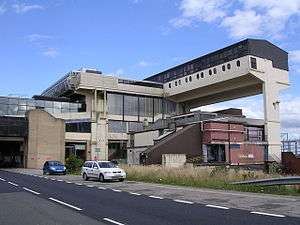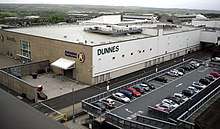Cumbernauld town centre
Cumbernauld town centre is the commercial centre of the new town of Cumbernauld, Scotland. It was designed in the 1950s—as what became known as a megastructure—to be a town centre consisting of "one huge multi-storey building," according to its preliminary planning report, housing shops, apartments, a hotel, ice rink, police station and other amenities.[8]
| Cumbernauld town centre | |
|---|---|
 Cumbernauld town centre, 2006 | |
 Location within Scotland | |
| General information | |
| Architectural style | Brutalism[1] |
| Location | Cumbernauld, Scotland |
| Current tenants | 75 tenants[2] |
| Construction started | 1963 |
| Opened | 25 May 1967[3] |
| Owner | Belgate Estates, Glasgow[2][4] |
| Landlord | Gatehouse Property Management, Glasgow[5] |
| Technical details | |
| Floor count | Eight[6] |
| Floor area | 270,000 sq ft[2] |
| Design and construction | |
| Architecture firm | Leslie Hugh Wilson, Dudley Roberts Leaker[1] Geoffrey Copcutt, Philip Aitken, Neil Dadge[7] |
| Main contractor | Cumbernauld Development Corporation[1] |
| Website | |
| cumbernauldcentre.com/ (archived 9 September 2015) | |
Phase 1 was completed between 1963 and 1967,[7] and the centre was opened by Princess Margaret and Lord Snowdon in May 1967.[3] It was expanded in 2007 by the addition of the Antonine Centre, a shopping centre that is linked to the older structure by walkways and lifts.
The facility has been subject to harsh criticism over the years. It was voted "Britain's most hated building" in 2005, in a poll organised by Channel 4's programme Demolition,[6] and was twice named Scotland's worst town centre by the Carbuncle Awards.[9] The top section of the building has been dubbed by writers including author Caro Ramsay as the "Alien's Head",[10][11] due to local people observing a resemblance to fictional character E.T.[10]
History
Cumbernauld was designated as a new town in December 1955,[12] part of a plan, under the New Towns Act 1946, to move 550,000 people out of Glasgow and into new towns to solve the city's overcrowding.[13][lower-alpha 1] Construction of its town centre began under contractors Duncan Logan, chief architect Leslie Hugh Wilson and architect Geoffrey Copcutt (until 1962 and 1963), and later Dudley Roberts Leaker, Philip Aitken and Neil Dadge.[1][7]
Phase 1 lasted from 1963 to 1967.[7] The idea was to create a megastructure, in the brutalist style, to accommodate a town of 50,000–80,000 people,[18] although architecture historian John R. Gold notes that the term megastructure was first coined in 1964.[19] Regarded at the time as a "milestone in urban design,"[20] the centre would be surrounded by high-density housing without shops or other amenities, with each neighbourhood connected to the structure by pathways so that residents could easily walk there.[18] Architectural critic Wolf von Eckardt wrote in Harper's in 1965:
Leonardo da Vinci, nearly five hundred years ago, envisioned a city where all the vehicles move underground, leaving man to move freely in the sun. Leonardo might also have sketched Cumbernauld's town center, a soaring citadel surrounded by meadow."[21]
Princess Margaret and Lord Snowden opened the centre on 25 May 1967.[3] Built over a dual carriageway,[18] it housed shops, a hotel, ice rink, bowling alley, health centre and penthouse apartments, as well as police, fire and ambulance stations. There was also a library and technical college. Historian Rosemary Wakeman called it a "colossal living vessel" intended to "elicit new codes of community behavior."[22] According to an Open University website, it was a "strange tribute to a moment when it was thought that old cities, with their narrow streets, haphazard layout, and confused, illogical centres were a thing of the past."[18]
Later development
.jpg)
By 1971 the town centre contained the largest supermarket in Scotland and work on phase 2 had begun. The Corporation sought the building of a department store, completed in 1975 as phase 3. It was built for Woolco with two levels of underground parking, and was sold to Gateway in 1986. Asda purchased the site in 1988 and maintained the "Red Balloon Cafe" that was widely implemented in Gateway stores. In the mid-70s the Golden Eagle Hotel closed and was later demolished after a vehicle crashed into the building. Phase 4 was completed in 1981.
The structure was purchased by a shopping management group in 1996 when Cumbernauld Development Corporation was wound up. Phase 3 was demolished in 1996 and in 2001 the rear outdoor section of phase 1 was demolished. The new Antonine Centre was built on those sites in 2006. The centre, with 350,000 square feet (33,000 m2) of retail space, was opened on 6 June 2007 by Princess Anne.
Gallery
 Alien's Head, 2013
Alien's Head, 2013.jpg) Town centre, 2012
Town centre, 2012 Cumbernauld shopping centre, 2013
Cumbernauld shopping centre, 2013 Antonine Centre, 2009
Antonine Centre, 2009
See also
- List of brutalist structures
Notes
- Other new towns were East Kilbride (1947),[14] Glenrothes (1948),[15] Livingston (1962)[16] and Irvine (1966).[17]
References
- "Town centre, Cumbernauld New Town: close-up of the megastructure facade", Royal Institute of British Architects.
- "Cumbernauld Town Centre, Cumbernauld", Belgate Estates.
- "Princess Margaret In Cumbernauld 1967", British Pathé.
- "Cumbernauld shopping complex under threat as rivals claim it derails vision", Evening Times (Glasgow), 12 July 2016.
- "Westfield retail park hits unexpected snag after town centre bosses get tough", Cumbernauld News, 28 July 2016.
- "Cumbernauld tops demolition poll". BBC News. 11 December 2005.
- John R. Gold, "The making of a megastructure: architectural modernism, town planning and Cumbernauld’s central area, 1955-75", Planning Perspectives, 21, April 2006 (109–131), 121–122. doi:10.1080/02665430600555255
- John R. Gold, The Practice of Modernism: Modern Architects and Urban Transformation, 1954–1972, Routledge, 2007, 173.
- Cumbernauld, BBC News, 25 May 2012.
- "What's it called? Carbuncle-nauld". Airdrie & Coatbridge Advertiser. 21 November 2001.
[T]he centre is topped by a rather unsightly block ... Cumbernauld residents dubbed [it] the 'Alien's Head', in homage to ET.
- Caro Ramsay (6 December 2013). "What's it called? Cumbernauld!". Murder is Everywhere. Retrieved 9 February 2014.
...the centre's penthouses located within the 'alien's head' lie empty and derelict.
- "No. 17351". The Edinburgh Gazette. 13 December 1955. p. 746.
- Gold 2006.
- "No. 16436". The Edinburgh Gazette. 9 May 1947. p. 189.
- "No. 16556". The Edinburgh Gazette. 2 July 1948. pp. 299–300.
- "No. 18025". The Edinburgh Gazette. 17 April 1962. pp. 236–237.
- "No. 18509". The Edinburgh Gazette. 11 November 1966. p. 846.
- "Cumbernauld Town Centre", Open University, 26 November 2001.
- Gold 2007, 172.
- Rosemary Wakeman, Practicing Utopia: An Intellectual History of the New Town Movement, University of Chicago Press, 2016, 271.
- Wolf von Eckardt, "The Case for Building 350 New Towns," Harper's Magazine, December 1965, 93, cited in Wakeman 2016, 271.
- Wakeman 2016, 272.
External links
- Official website, archived 9 September 2015.
- "Cumbernauld – Town Centre Redevelopment", glasgowarchitecture.co.uk, 9 January 2009.
- Model of phase 1 (1963–1967)
- Cumbernauld town centre 1966
- Model of town centre
- "Cumbernauld town centre" poster